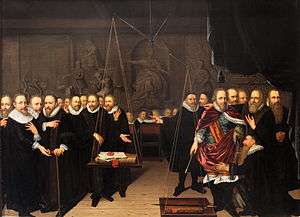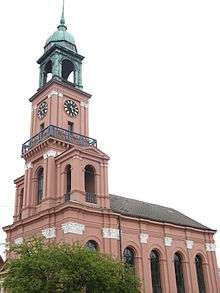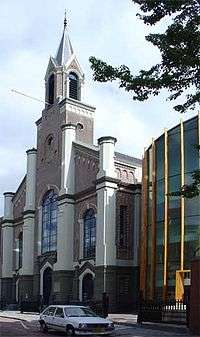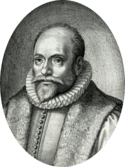Remonstrants
The Remonstrants (or the Remonstrant Brotherhood) is a Protestant movement that had split off of the Dutch Reformed Church in the early 17th century. The early Remonstrants supported Jacobus Arminius, and after his death, continued to maintain his original views called Arminianism against the proponents of Calvinist orthodoxy. Condemned by the synod of Dort (1618-1619), the Remonstrants remained in a small minority in the Netherlands. In the middle of the 19th century, the Remonstrant Brotherhood was influenced by the liberal Dutch theological movement.
| Remonstrants | |
|---|---|
| Classification | Protestant |
| Theology | Arminianism |
| Origin | early 17th century Netherlands |
| Separated from | Dutch Reformed Church |
History

Foundation
In formulating Arminianism, Jacobus Arminius disagreed with Calvin, especially on predestination. He defended free examination as superior to the doctrines of established churches.
In 1610, Arminius followers presented to the States of Holland and Friesland a remonstrance in five articles formulating their points of disagreement with Calvinism as adopted by the Dutch Reformed Church.[1]
As historic supporters of his theological cause, Remonstrants declined to be called "Arminians" (after the Roman Catholic practice of labeling a heresy after its founder) and adopted a designation of their own choice.
Their adversaries, inspired by Franciscus Gomarus, became known as Gomarists or Counter-Remonstrants.[1] Although the States-General issued an edict tolerating both parties and forbidding further dispute, the conflict continued[1] and became linked to political conflicts in the Dutch Republic. The Remonstrants were assailed both by personal enemies and by the political weapons of Maurice of Orange.[1] Their foremost ally, Johan van Oldenbarnevelt, was executed, and other leaders were imprisoned.
In 1618–19 the Synod of Dordrecht, after expelling the thirteen Arminian pastors headed by Simon Episcopius, established the victory of the Calvinist school.[1] It drew up ninety-three canonical rules, and confirmed the authority of the Belgic Confession and the Heidelberg Catechism.[1] The judgement of the synod was enforced through the deposition and in some cases banishment of Remonstrant ministers.[1] In this context, owing to the lack of preachers, there originated in Warmond a movement in favor of the lay sermon, the adherents of which founded the Society of Collegiants.[2] An exile community of Remonstrants was founded in Antwerp in 1619. In 1621 they were allowed to settle in Schleswig, where they built the town of Friedrichstadt.[1]
Institutionalization

The doctrine of the Remonstrants was embodied in 1621 in a Confession[3] written by Episcopius, their major theologian. This Confession serves as a base for the Remonstrant church since his return to the Netherlands in 1626. It confirms the opinion of the remonstrants already expressed in 1618.[4]
Jan Uytenbogaert gave to the Remonstrants a catechism and regulated their church order.[1] Their seminary in Amsterdam had distinguished pupils, including Curcellaeus, Limborch, Wetstein, and Le Clerc. Their school of theology, which grew more liberal and even rationalistic, forcefully debated the official Dutch Reformed state church and other Christian denominations.[1]
After the death of Maurice of Orange in 1625 some exiles returned. The government became convinced that they posed no danger to the state, and in 1630 they were formally allowed to reside again in all parts of the Republic.[1] They were not, however, officially allowed to build churches until the establishment of the Batavian Republic in 1795. Until then they held their services in so-called Schuilkerken (house churches).[5]
Liberalism
In the mid-19th century, the Remonstrant Brotherhood was influenced by liberalism,[6][7] which in Holland was embodied by Petrus Hofstede de Groot (1802-1886). His theology had a wide audience in Europe, which is characteristic of the romantic phase of Christian humanism; in the Netherlands, this line of thought has been represented by the "theologians of Groningen" since 1830.
De Groot sums up the purpose of this movement of which he is the leader by writing that "the most important thing in Christianity is the revelation and the education as given by God in Jesus Christ, so as to make us more and more like God". The "Groningers" reject the dogma of the Trinity, predestination and expiatory justice of God. They recognize the dual divine and human nature and the ability of man to fulfill God's will with His help.
Early Remonstrants theological legacy
Most of the early Remonstrants followed classical Arminianism.[8] However they are not the only Protestants who can be considered Arminian or be called "Arminians". The Arminian movement is a cross-denominational development which made inroads into the Church of England, Methodism, General Baptists, the Adventist Church, the Holiness movement, Pentecostalism, the Charismatic movement, and a number of other Protestant denominations.
Modern Remonstrant Brotherhood

The church
The Remonstrant Brotherhood continues as a church in the Netherlands. The Remonstrants first received official recognition in 1795. Their chief congregation has been in Rotterdam.[9]
In 2016, the Remonstrant Brotherhood has about 5,000 members and "friends", in more than 40 congregations in the Netherlands,[10] and one congregation in Friedrichstadt, in northern Germany (2008).[11]
The Remonstrant Brotherhood of Holland keeps fellowship with the European Liberal Protestant Network. Besides it is a full, charter member of the World Alliance of Reformed Churches. Remonstrants are frequently Unitarians.
In line with the progressive views on religion, Remonstrants have been blessing same-sex partnerships on an equal footing as different sex weddings from 1986 onwards (church weddings have no legal status in the Netherlands, where the legally acknowledged civil same-sex marriages became possible in 2001).[12][13] In this the Remonstrants were the first Christian church in the world to bless same-sex relationships similar to other relations.[14]
Remonstrants place big emphasis on personal faith and are not in agreement with one another on questions of faith and social issues. They consider that the message of the Gospel can not be separated from true choices in the struggle to live together, on the road to a world with peace and justice.[15] What binds them is the Statement of Principle:
The Remonstrant Church is a community of faith which, rooted in the gospel of Jesus Christ, and true to its principle of freedom and tolerance, seeks to worship and serve God.
Confessions of faith
In addition to Statement of Principle, most contemporary Remonstrants write their own declaration or profession of faith when they become a member of the community. The brotherhood did express at three times in their history the faith they share in a confessional statement, in 1621, 1940 and 2006. Remonstrants however, being a non-creedal denomination, consider no confession to have indisputable authority.[12]
Notes and references
Citations
- Chisholm 1911.
- Schaff & Herzog 1953, Chap. 2.
- Episcopius & Ellis 2005.
- DeJong 1968, pp. 220-. 1. that the divine decree of predestination is conditional, not absolute; 2. that the Atonement is in intention universal; 3. that man cannot of himself exercise a saving faith; 4. that though the grace of God is a necessary condition of human effort, it does not act irresistibly in man; and 5. that believers are able to resist sin but are not beyond the possibility of falling from grace.
- Benedict 2008, p. 313.
- Zijpp 1959.
- Olson 2012. I completely omit [as a reference for defining Arminianism] “Arminians of the head,” those Remonstrants and their heirs who veered off into rationalism, deism and liberalism. For the most part they stopped identifying as Arminians anyway.
- Olson 2012, ..
- Schaff & Herzog 1953, Chap. 3-4.
- LBR 2016.
- LBR 2015.
- LBR 2019.
- nu.nl 2011.
- Trouw.nl 2010.
- LBR 2006.
Sources
- Benedict, Philip (2008). Christ's Churches Purely Reformed: A Social History of Calvinism.CS1 maint: ref=harv (link)

- DeJong, Peter (1968). "The Opinions of the Remonstrants (1618)". Crisis in the Reformed Churches: Essays in Commemoration of the Great Synod of Dordt, 1618-1619 (PDF). Grand Rapids: Reformed Fellowship.CS1 maint: ref=harv (link)
- Episcopius, Simon; Ellis, Mark A. (2005). The Arminian confession of 1621 (PDF). Eugene: Pickwick Publications.CS1 maint: ref=harv (link)
- nu.nl (2011). "Kerken komen uit de kast in boek" (in Dutch). nu.nl. Retrieved 2019-09-22.CS1 maint: ref=harv (link)
- LBR (2019). "Belijdenis" (in Dutch). Landelijk Bureau Remonstranten. Retrieved 2019-08-15.CS1 maint: ref=harv (link)
- LBR (2015). "Remonstrant Church". Landelijk Bureau Remonstranten. Retrieved 2016-01-23.CS1 maint: ref=harv (link)
- LBR (2016). "Deel 2 Commissie tot de Zaken - Activiteiten" (PDF) (in Dutch). Landelijk Bureau Remonstranten. Retrieved 2019-09-15.CS1 maint: ref=harv (link)
- Olson, Roger E. (2012). "Who Is (or Might Be) an Arminian?". Roger E. Olson: My evangelical, Arminian theological musings. Patheos. Retrieved 2019-08-27.CS1 maint: ref=harv (link)
- Trouw.nl (2010). "Remonstranten en Boomsma krijgen homo-emancipatieprijs - Nieuws - TROUW" (in Dutch). Trouw.nl. Retrieved 2012-09-09.CS1 maint: ref=harv (link)
- Schaff, Phillip; Herzog, Jakob (1953). "Remonstrants". The New Schaff-Herzog Encyclopedia of Religious Knowledge. 9. Grand Rapids: Baker.CS1 maint: ref=harv (link)
- Zijpp, Nanne van der (1959). "Remonstrants". Global Anabaptist Mennonite Encyclopedia Online.CS1 maint: ref=harv (link)
Further reading
- Aken, Lucie J N K van, 1947. De Remonstrantse Broederschap in Verleden en Heden. Historische Schets, Arnhem: Van Loghum Slaterus
- Brouwers, J F e.a. (red), 2005. Wat We Nog Weten. Amsterdamse Remonstranten in de 20ste eeuw. 375-jarig Bestaan Remonstrantse Gemeente Amsterdam, Amsterdam: Remonstrantse Gemeente Amsterdam
- Barnard, T, 2006. Van verstoten kind tot belijdende kerk: de Remonstrantse Broederschap tussen 1850 en 1940, Amsterdam: De Bataafsche Leeuw
- Barnard, T en E Cossee, 2007. Arminianen in de Maasstad: 375 jaar Remonstrantse Gemeente Rotterdam, Amsterrdam: De Bataafsche Leeuw
- Cossee, E, 1988. Abraham des Amorie van der Hoeven, 1798-1855: een Remonstrants theoloog in de Biedermeiertijd, Kampen: Kok
- Cossee, E, Th M van Leeuwen, M A Bosman-Huizinga, 2000. De remonstranten, Kampen: Kok
- Episcopius, Simon, 1627. Vrye godes-dienst, of t'Samen-spreeckinghe tusschen Remonstrant en Contra-Remonstrant, over de vrye godts-dienstighe vergaderinghen der Remonstranten.: Met wederlegginge van Douchers oproerighe predicatie: C. Dungani redeloose salvatien, &c.
- Goud, J en K Holtzapffel (red), 2004. Wij Geloven - Wat Geloven Wij?. Remonstrants Belijden in 1940 en Nu. Zoetermeer: Meinema
- Keune, W T, C Ginjaar, J Schaafstra, 1978. Doopsgezind en Remonstrant in Dokkum, Van der Helm
- Sirks, G J, 1955. Verantwoording en verantwoordelijkheid van ons Remonstrant-zijn, Lochum: De Tijdstroom
- Slis, P L, 2006. De Remonstrantse Broederschap: Biografische Naamlijst, 1905-2005 : Gemeenten, Landelijke Organen, Predikanten en Proponenten, Publicaties, Eburon
- Vuyk, Simon, 2002. De Dronken Arminiaanse Dominee. Over de Schaduwzijde der Verlichte Remonstranten, Amsterdam: De Bataafsche Leeuw
